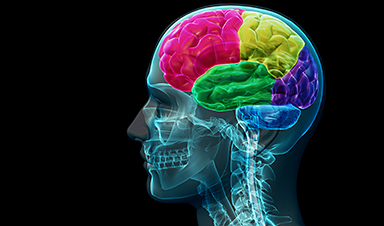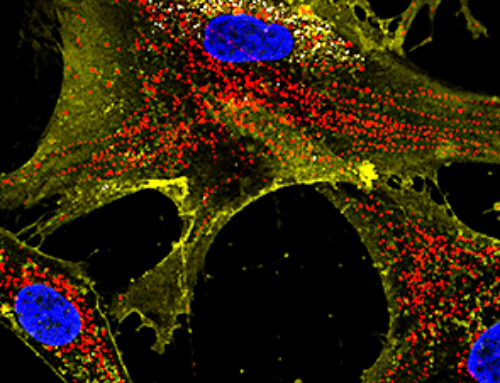Researchers have created nanoscale robots which could be used to manage bleeds in the brain caused by aneurysms. The development could enable precise, relatively low-risk treatment of brain aneurysms, which cause around 500,000 deaths globally each year. The medical condition—a blood-filled bulge on a brain artery that can rupture and cause fatal bleeds—can also lead to stroke and disability.
The study points to a future where tiny robots could be remotely controlled to carry out complex tasks inside the human body—such as targeted drug delivery and organ repair—in a minimally invasive way, researchers say.
Swarming bots
The team, involving researchers from the University of Edinburgh, engineered magnetic nanorobots—about a twentieth the size of a human red blood cell—comprising blood-clotting drugs encased in a protective coating, designed to melt at precise temperatures. The work is published in the journal Small.
In lab tests, several hundred billion such bots were injected into an artery and then remotely guided as a swarm, using magnets and medical imaging, to the site of an aneurysm.
Magnetic sources outside the body then cause the robots to cluster together inside the aneurysm and be heated to their melting point, releasing a naturally occurring blood-clotting protein, which blocks the aneurysm to prevent or stem bleeding into the brain.
Lab trials
The international team, co-led by clinicians from Shanghai Sixth People’s Hospital affiliated to Shanghai Jiao Tong University School of Medicine in China, successfully tested their devices in model aneurysms in the lab and in a small number of rabbits.
The team says that nanorobots show potential for transporting and releasing drug molecules to precise locations in the body without risk of leaking into the bloodstream—a key test of the technology’s safety and efficacy.
The study could pave the way for further developments towards trials in people.
Promising potential
Their advancement could improve on current treatments for brain aneurysms. Typically, doctors thread a tiny microcatheter tube along blood vessels before using it to insert metal coils to stem the aneurysm blood flow, or a mesh tube called a stent, to divert the bloodstream in the artery.
Researchers say their new technique could decrease the risk that the body will reject implanted materials, and curb reliance on anti-blood-clotting drugs, which can cause bleeding and stomach problems.
The method also avoids the need for doctors to manually shape a microcatheter to navigate a complex network of small blood vessels in the brain to reach the aneurysm—a painstaking task which may take hours during surgery, researchers say.
Larger brain aneurysms—which can be difficult to stem quickly and safely using metal coils or stents—could potentially be treated using the new technique too.
The study was led by a team from the UK and China who have also developed nanorobots to remove blood clots, which show potential in treating stroke.
“Nanorobots are set to open new frontiers in medicine—potentially allowing us to carry out surgical repairs with fewer risks than conventional treatments and target drugs with pinpoint accuracy in hard-to-reach parts of the body. Our study is an important step towards bringing these technologies closer to treating critical medical conditions in a clinical setting,” Dr. Qi Zhou.
More information: Jienan Wang et al, Nanoarchitectonic Engineering of Thermal‐Responsive Magnetic Nanorobot Collectives for Intracranial Aneurysm Therapy, Small (2024). DOI: 10.1002/smll.202400408
Journal information: Small
Provided by University of Edinburgh
News
Novel mRNA therapy curbs antibiotic-resistant infections in preclinical lung models
Researchers at the Icahn School of Medicine at Mount Sinai and collaborators have reported early success with a novel mRNA-based therapy designed to combat antibiotic-resistant bacteria. The findings, published in Nature Biotechnology, show that in [...]
New skin-permeable polymer delivers insulin without needles
A breakthrough zwitterionic polymer slips through the skin’s toughest barriers, carrying insulin deep into tissue and normalizing blood sugar, offering patients a painless alternative to daily injections. A recent study published in the journal Nature examines [...]
Multifunctional Nanogels: A Breakthrough in Antibacterial Strategies
Antibiotic resistance is a growing concern - from human health to crop survival. A new study successfully uses nanogels to target and almost entirely inhibit the bacteria P. Aeruginosa. Recently published in Angewandte Chemie, the study [...]
Nanoflowers rejuvenate old and damaged human cells by replacing their mitochondria
Biomedical researchers at Texas A&M University may have discovered a way to stop or even reverse the decline of cellular energy production—a finding that could have revolutionary effects across medicine. Dr. Akhilesh K. Gaharwar [...]
The Stunning New Push to Protect the Invisible 99% of Life
Scientists worldwide have joined forces to build the first-ever roadmap for conserving Earth’s vast invisible majority—microbes. Their new IUCN Specialist Group reframes conservation by elevating microbial life to the same urgency as plants and [...]
Scientists Find a Way to Help the Brain Clear Alzheimer’s Plaques Naturally
Scientists have discovered that the brain may have a built-in way to fight Alzheimer’s. By activating a protein called Sox9, researchers were able to switch on star-shaped brain cells known as astrocytes and turn them into [...]
Vision can be rebooted in adults with amblyopia, study suggests
Temporarily anesthetizing the retina briefly reverts the activity of the visual system to that observed in early development and enables growth of responses to the amblyopic eye, new research shows. In the common vision [...]
Ultrasound-activated Nanoparticles Kill Liver Cancer and Activate Immune System
A new ultrasound-guided nanotherapy wipes out liver tumors while training the immune system to keep them from coming back. The study, published in Nano Today, introduces a biodegradable nanoparticle system that combines sonodynamic therapy and cell [...]
Magnetic nanoparticles that successfully navigate complex blood vessels may be ready for clinical trials
Every year, 12 million people worldwide suffer a stroke; many die or are permanently impaired. Currently, drugs are administered to dissolve the thrombus that blocks the blood vessel. These drugs spread throughout the entire [...]
Reviving Exhausted T Cells Sparks Powerful Cancer Tumor Elimination
Scientists have discovered how tumors secretly drain the energy from T cells—the immune system’s main cancer fighters—and how blocking that process can bring them back to life. The team found that cancer cells use [...]
Very low LDL-cholesterol correlates to fewer heart problems after stroke
Brigham and Women's Hospital's TIMI Study Group reports that in patients with prior ischemic stroke, very low achieved LDL-cholesterol correlated with fewer major adverse cardiovascular events and fewer recurrent strokes, without an apparent increase [...]
“Great Unified Microscope” Reveals Hidden Micro and Nano Worlds Inside Living Cells
University of Tokyo researchers have created a powerful new microscope that captures both forward- and back-scattered light at once, letting scientists see everything from large cell structures to tiny nanoscale particles in a single shot. Researchers [...]
Breakthrough Alzheimer’s Drug Has a Hidden Problem
Researchers in Japan found that although the Alzheimer’s drug lecanemab successfully removes amyloid plaques from the brain, it does not restore the brain’s waste-clearing system within the first few months of treatment. The study suggests that [...]
Concerning New Research Reveals Colon Cancer Is Skyrocketing in Adults Under 50
Colorectal cancer is striking younger adults at alarming rates, driven by lifestyle and genetic factors. Colorectal cancer (CRC) develops when abnormal cells grow uncontrollably in the colon or rectum, forming tumors that can eventually [...]
Scientists Discover a Natural, Non-Addictive Way To Block Pain That Could Replace Opioids
Scientists have discovered that the body can naturally dull pain through its own localized “benzodiazepine-like” peptides. A groundbreaking study led by a University of Leeds scientist has unveiled new insights into how the body manages pain, [...]
GLP-1 Drugs Like Ozempic Work, but New Research Reveals a Major Catch
Three new Cochrane reviews find evidence that GLP-1 drugs lead to clinically meaningful weight loss, though industry-funded studies raise concerns. Three new reviews from Cochrane have found that GLP-1 medications can lead to significant [...]





















